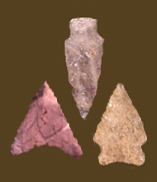
|
POPLAR ISLAND Defining Attributes Chronology Age estimates for the Poplar Island point vary. Custer (1996a) suggests a date range between 7000 and 1000 BP (roughly 5900 BC-1000 AD in calendar years), and he indicates that the Poplar Island was rare until 5000 BP, that specimens greater than 2 inches long predominated from 4500 to 2000 BP (approximately 3250 BC-50 AD in calendar years), and that smaller examples were most common after 2000 BP. Kent (1996) reports radiocarbon dates in and around southeastern Pennsylvania that range from 5310 BP to 4000 BP (roughly 4200 to 2500 BC calendar), but suggests that the younger dates may be in error and that use of the type centered around 5000 BP. Kraft (1975) excavated a feature on a Poplar Island site in the Upper Delaware River Valley that had a radiocarbon date of 3920 +/- 95 BP (approximately 2450 BC calendar). Witthoft (1959) and Kraft (1975) associate Poplar Island with the Late Archaic period Bare Island and Lackawaxen types, while Kinsey (in Ritchie 1971) notes a relationship with Terminal Archaic period steatite vessels. At the Abbott Farm site in New Jersey, Poplar Island-like points were found in Early and Middle Woodland contexts (Wall et al. 1996). Description Blade: The blade is generally a symmetrical, slender, triangular or lanceolate shape. It is usually biconvex in cross section, but some are flat. Edges are straight to slightly excurvate. The tip tends to be sharp and centered with the stem. There is no medial ridge. The shoulders are rounded, and in some cases are nearly non-existent. Haft Element: The stem is often relatively long, and its sides taper toward the base. The base is convex, and sometimes is almost pointed. The basal corners are rounded. Edge grinding is often present. Size: Length ranges from 30 to 122 mm, with 50 to 75 mm common. Width ranges from 12 to 37 mm. Thickness ranges from 5 to 23 mm, but most are under 11 mm. Technique of manufacture: Moderately well-made by percussion flaking. Material: In the middle Potomac River Valley, rhyolite and quartzite Poplar Islands are most common, with occasional examples of quartz and chert (Hranicky 2002). In Delaware, quartz, quartzite, and argillite are most common, but other materials are also used (Custer 1996a). Discussion The shoulders of the Poplar Island are less well-defined than those of the somewhat similar Morrow Mountain II point, and its base is more rounded. A temporal and morphological overlap between the Poplar Island and other long, narrow points such as the Bare Island, Clagett, and Lackawaxen has been noted also (Stephenson and Ferguson 1963; Kinsey in Ritchie 1971; Wall et al. 1996). These narrow points differ mostly in the shape of their bases -- tapered, generalized side notched, or straight stemmed. Distinguishing these types is sometimes problematic. Defined in Literature Poplar Island points were named and described by Witthoft (1959). Kinsey produced the first formal definition, published in Ritchie (1961, revised 1971). References |
![]()
Search by Shape:
(See Projectile Point Typology) |

|
Thank you for visiting our website. If you have any
questions, comments, Copyright © 2002 by |

|

